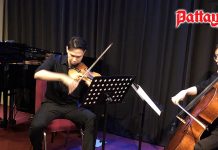Los Angeles (AP) – What happens to a film’s story when blades of grass are more interesting than the plot? When you can lean in so close to an actor you ought to feel their breath? When a few simple steps around a room can make you dizzy?
Virtual reality filmmakers are grappling with these challenges as they explore a medium that hasn’t had a century to develop the way movies have. Much the way early cinematographers had to discover cuts, wide shots and perspective, VR filmmakers find themselves making things up as they go along, often mashing up traditional movies and video-game techniques along the way.
 People react as they wear Samsung Gear VR goggles at CES International in Las Vegas, Jan. 6, 2016. (AP Photo/John Locher)
People react as they wear Samsung Gear VR goggles at CES International in Las Vegas, Jan. 6, 2016. (AP Photo/John Locher)
Consider for a second how we’ve all internalized the visual language of film. Quick cuts skip over time and space to get to a story’s point. Wide shots give us a godlike perspective. Zooms and tight focus naturally draw our attention to specific points. Audiences have been trained to stitch it all together into a fluid narrative.
Now picture yourself in the middle of the action. With a headset strapped over your eyes and ears, sometimes with a controller in your hand, you are completely immersed in the virtual world. Things can happen behind you. There are characters and places to explore from different angles.
It’s all a work in progress, one that more consumers will see when the long awaited Oculus Rift VR headset ships at the end of this month. It’s crucial for VR filmmakers to get storytelling right, or the whole virtual reality boom could turn out to be just another sandbox for hardcore video gamers.
This was one of the first lessons for Oculus Story Studio, a hub for digital animators and experimental filmmakers in San Francisco.
In an early version of the Oculus short “Lost,” audiences got distracted by looking at foliage or the moon and didn’t pay attention to a giant, disembodied hand that’s the subject of the piece, says creative director Saschka Unseld. So creators added a full 40 seconds to let viewers get oriented, and then just let go.
“Once you have the audience interested, they will look wherever the story happens,” Unseld says. “But losing that control of focus of the audience is something that took a while to get over.”
In “Henry,” another Oculus short, you find yourself standing inside a lonely hedgehog’s computer-generated house. You’re free to look around at anything, but it’s not until you set eyes on the kitchen door that Henry shows up.
“That’s a triggered moment that makes you feel like you discovered Henry in a very natural way,” says director Ramiro Lopez Dau. Some viewers try to hug Henry, Dau says — but he doesn’t hug back.
Vrse, a Los Angeles-based virtual reality studio that has worked with The New York Times, Vice News and others, has a signature documentary style involving a voice-over and stationary VR camera placement right in the middle of the action.
But it unhooked the camera in “Millions March NYC ,” an 8-minute VR documentary on racial-profiling protests that Vrse produced with Vice News. Creative director Chris Milk acknowledged the hand-held camera and bouncing, shaky movements make the viewer “a little queasy.”
It still proved a point. Turns out it’s not motion so much as the acceleration and deceleration that makes people feel sick — the same way taking off and landing in a plane feel a lot worse than just cruising at 30,000 feet.
Many virtual reality filmmakers avoid motion because it induces nausea, but Milk says injecting a touch of acceleration is a new way for directors to provoke an emotional response. “You couldn’t do this in a traditional, rectangular film,” he says.




